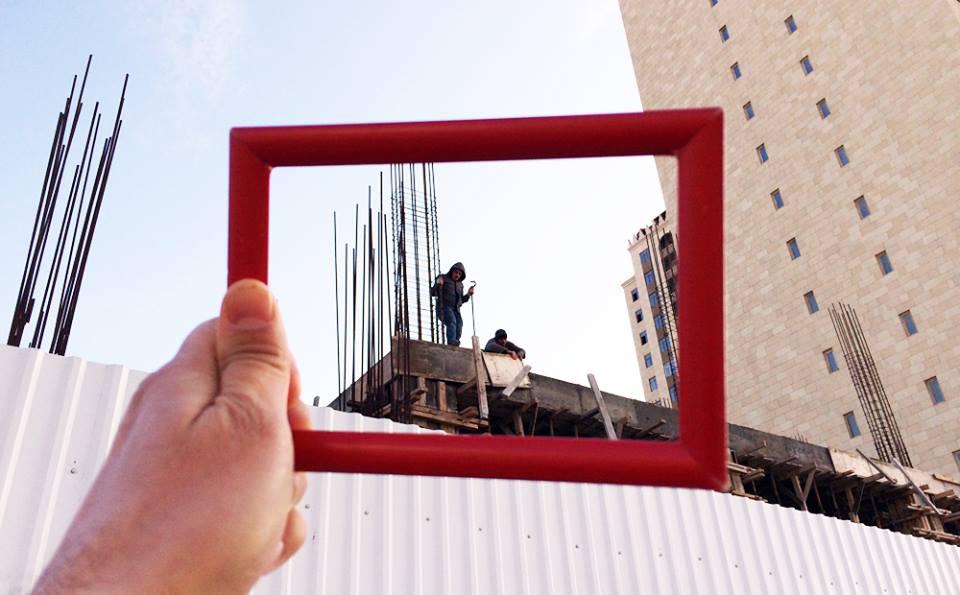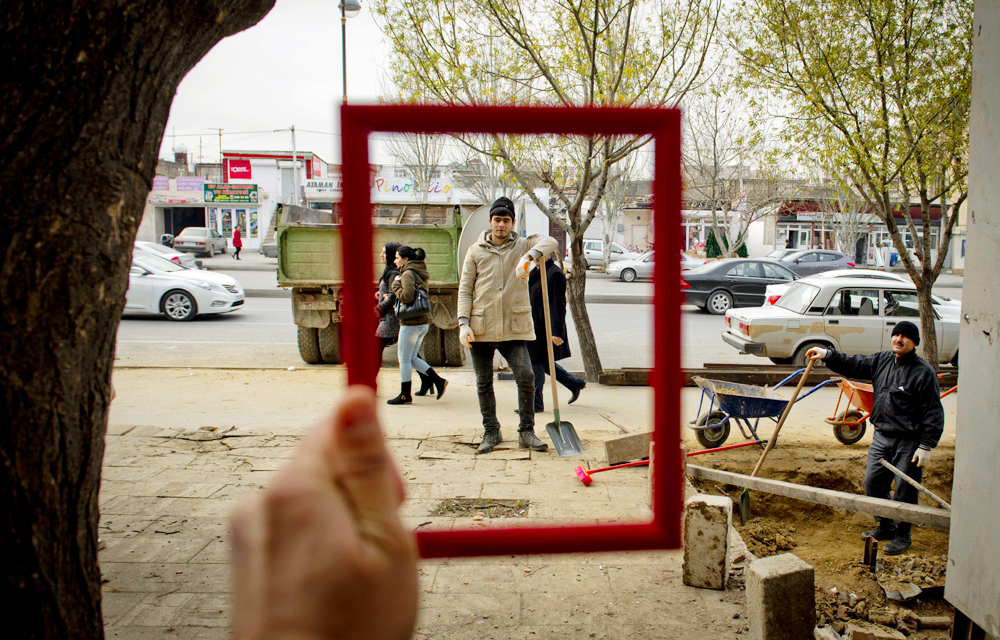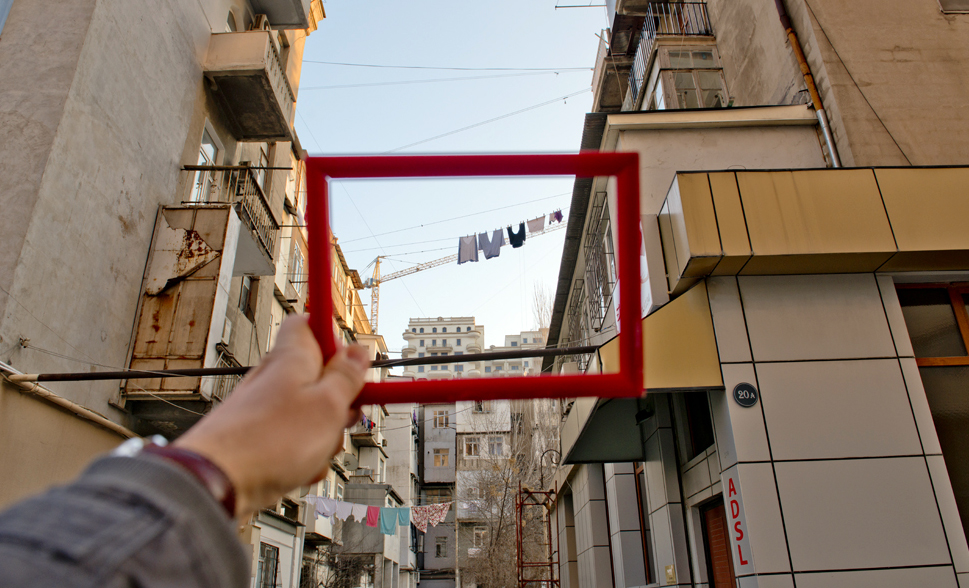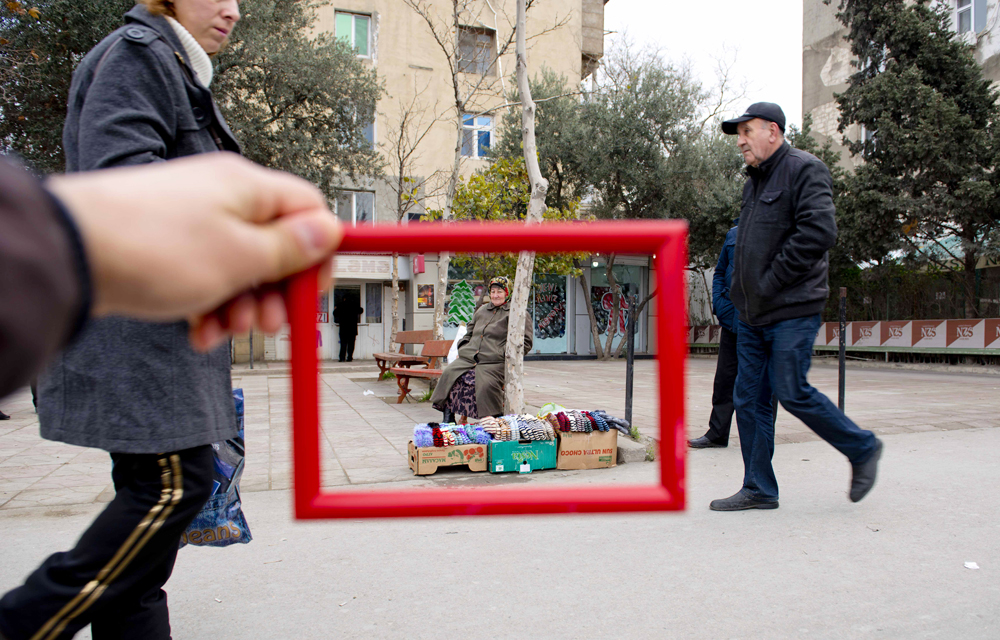The following is a photo essay by Ahmad Muxtar, a Baku-based photographer and the founder of Red Frame. You can follow the project on Facebook and Instagram. The accompanying text was written by Ajam Editor Rustin Zarkar.

Baku, Azerbaijan’s wind-swept capital city on the Caspian Sea, has seen tremendous changes to its urban landscape and social composition over the last two decades. Since the end of the Soviet Union, the government of Azerbaijan have initiated a number of urban projects and branding campaigns to transform the image of Baku from a Post-Soviet peripheral city to that of a modern business and tourism hub, often at the expense of the city’s more historic neighborhoods and buildings.
As Baku’s government-led urban development continues, citizens have launched a number of initiatives to record the daily life and social transformation of their capital. Ahmad Muxtar’s Red Frame is one such project that not only documents Baku’s architectural change, but also explores the ways our perceptions of urban space are framed by social, political, and economic forces. Over the next few months, Ajam will collaborating with community organizers in Baku like Muxtar to help document the city’s transformation. Ajam’s upcoming multi-media project, Mehelle (or neighborhood), will provide a platform to preserve the histories, stories, and images of unique neighborhoods across Ajamistan.

On the surface, Muxtar’s project is relatively straightforward: equipped with an Iphone and a simple red frame, the photographer scours the Baku streets, looking for places and scenes that highlight juxtapositions in the urban setting. Many of the photographs reveal tensions between visions of a future city and the Baku of the past. By choosing to focus on new construction projects and leaving the older parts of the city visibly “out of frame,” Muxtar replicates the perspective of the authorities and the business elite who have championed notions of “progress” at all costs.
In other instances, the photographer uses the red frame to highlight the lived experiences of the city’s inhabitants, whether it be an ephemeral moment in traffic or in the rain, or the remnants of family life in a once-inhabited neighborhood. Additionally, Muxtar also chooses to frame the disenfranchised of Baku, particularly pensioners trying to make ends meet, children playing in neighborhoods scheduled for destruction, and the construction workers who risk their lives for minimal pay to build Baku’s new cityscape.


Baku International: A Brief History
Baku’s urban development has been driven by its central location for trans-Caucasian and trans-Caspian trade as well as the historic presence of petroleum. Baku grew to become a cosmopolitan port in the late 1800s, as an oil rush transformed the city into an essential hub of the emergent global economy. By the turn of the 20th century, the city was responsible for 50% of the global oil production–attracting Russian garrisons, Armenian merchants, European millionaires like the Nobels and Rothchilds, pilgrims from Central Asia, and migrant workers from Iran and the Ottoman Empire.
During the Russian revolutions of 1905 and 1917, Baku maintained its internationalist atmosphere, as workers crossed ethnic lines to protest labor conditions in the oil fields and revolutionaries flocked to the area in the hopes of envisioning a new future for Asia. Following World War II, Baku experienced another wave of migration, as oil revenues stabilized socio-economic life in the city and attracted new communities from the Soviet Union. While divisions were visible (and discrimination of course existed), this was an era when multicultural, multiethnic, and multi-religious harmony was perceived as a social reality; Azerbaijanis, Russians, Armenians, Georgians, and Jews lived and worked side by side, sharing troubles and joys as neighbors and compatriots.


The composite nature of the city’s populace in the 20th century mirrors the architectural character of the city, as Shirvanid, Safavid, Tsarist, and Soviet rule created a patchwork of distinct styles that are visible to this day — from Islamicate to Neo-classical, and Neo-Baroque to Constructivism. These influences are still visible to this day and can be (more or less) geographically located in concentric circles, stemming from the “Inner City” (İçərişəhər), comprised of the medieval citadel and its labyrinthine streets. The second circle corresponds to 19th and early 20th century Tsarist Russian rule, when an influx of global capital from the oil boom led to the rapid development of neighborhoods both for the wealthy oil barons and technocrats, as well as for the impoverished workers. The third and final circle was constructed in the Soviet Period and consists of large housing blocks and industrial complexes.
Since the collapse of the Soviet Union in 1991, however, both the social and architectural pluralism of the city has been under threat. As Azerbaijan gained independence, it was already embroiled in a devastating war with neighboring Armenia over the status of the Nagorno-Karabakh region. The war led to of ethnic violence in both Armenia and Azerbaijan. Much of Baku’s non-Azeri communities were gone by the time an uneasy ceasefire was agreed upon in 1994. Furthermore, a massive flight of refugees from the warzone created a crisis due to a lack of sufficient space and resources in the capital to accommodate those displaced from the countryside.

Neighborhoods Under Threat
Many of the social problems documented in Muxtar’s photographs are a result of the dramatic economic changes that occurred during 1990s. As the war with Armenia raged, Azerbaijan also prepared to make the transition to a state-led capitalist economy, following IMF and World Bank privatization strategies. The most significant development was marked by a 1994 agreement signed between the Azerbaijani state and an international consortium of foreign oil companies. The so-called “Contract of the Century,” coupled with rising oil prices, provided Azerbaijan with billions of dollars of revenue in the form of rent.
While authorities and planners were primarily concerned with apartment blocks to house refugees during the first decade of independence, since the 2000s Azerbaijani elites have initiated ambitious construction projects — large glass and steel buildings, new boulevards, and renovated waterfronts — with the hopes of attracting foreign investment. This construction boom breaks from the concentric circle pattern of urban development, as new projects appear to be scattered all over Baku.

These projects also require the demolition of historic buildings and entire neighborhoods — as well as the relocation of hundreds of families. Although many citizens are content with the city adminstration’s plans new vision for Baku, a sizeable segment of the population have voiced their discontent for low-compensation rates and the destruction of cultural heritage. Even with falling oil prices and the 2015-16 manat devaluation crisis, construction projects are still being pushed forward, particularly in the historic Sovestki neighborhood located in the heart of the capital.
Muxtar believes that Red Frame project will not only help raise awareness of what is being lost through Baku’s urbanization, but that that the idea can be replicated in other cities across the globe. He is currently developing an app that will allow users to explore the types of frames that exist in their own surroundings.














1 comment